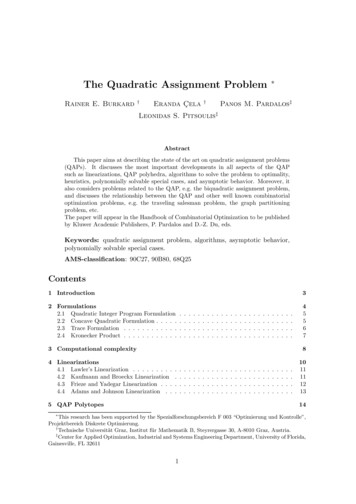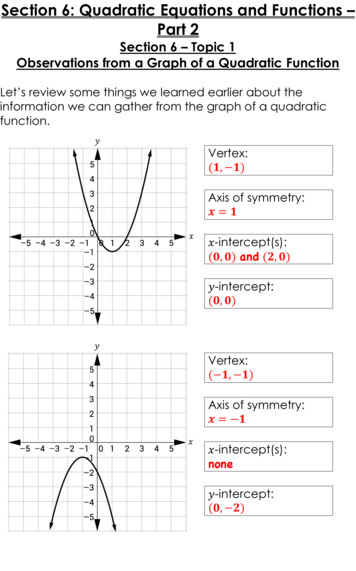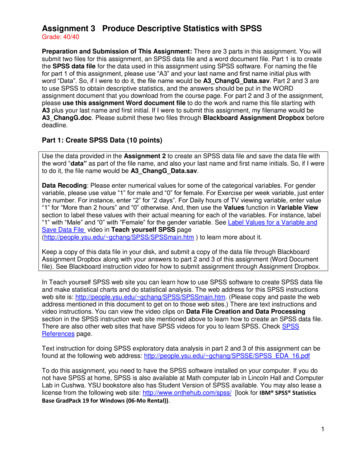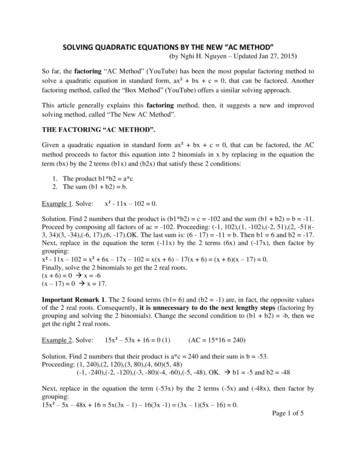
Transcription
The Quadratic Assignment ProblemRainer E. Burkard†Eranda Çela†Panos M. Pardalos‡Leonidas S. Pitsoulis‡AbstractThis paper aims at describing the state of the art on quadratic assignment problems(QAPs). It discusses the most important developments in all aspects of the QAPsuch as linearizations, QAP polyhedra, algorithms to solve the problem to optimality,heuristics, polynomially solvable special cases, and asymptotic behavior. Moreover, italso considers problems related to the QAP, e.g. the biquadratic assignment problem,and discusses the relationship between the QAP and other well known combinatorialoptimization problems, e.g. the traveling salesman problem, the graph partitioningproblem, etc.The paper will appear in the Handbook of Combinatorial Optimization to be publishedby Kluwer Academic Publishers, P. Pardalos and D.-Z. Du, eds.Keywords: quadratic assignment problem, algorithms, asymptotic behavior,polynomially solvable special cases.AMS-classification: 90C27, 90B80, 68Q25Contents1 Introduction32 Formulations2.1 Quadratic Integer Program Formulation2.2 Concave Quadratic Formulation . . . . .2.3 Trace Formulation . . . . . . . . . . . .2.4 Kronecker Product . . . . . . . . . . . .3 Computational complexity4 Linearizations4.1 Lawler’s Linearization . . . . . . . . .4.2 Kaufmann and Broeckx Linearization4.3 Frieze and Yadegar Linearization . . .4.4 Adams and Johnson Linearization . .455678.5 QAP Polytopes.101111121314 This research has been supported by the Spezialforschungsbereich F 003 “Optimierung und Kontrolle”,Projektbereich Diskrete Optimierung.†Technische Universität Graz, Institut für Mathematik B, Steyrergasse 30, A-8010 Graz, Austria.‡Center for Applied Optimization, Industrial and Systems Engineering Department, University of Florida,Gainesville, FL 326111
2CONTENTS6 Lower Bounds6.1 Gilmore-Lawler Type Lower Bounds . . . . . . . .6.2 Bounds Based on Linear Programming Relaxations6.3 Variance Reduction Lower Bounds . . . . . . . . .6.4 Eigenvalue Based Lower Bounds . . . . . . . . . .6.5 Bounds Based on Semidefinite Relaxations . . . . .6.6 Improving Bounds by Means of Decompositions . .171723252631337 Exact Solution Methods7.1 Branch and Bound . . . . . . . . . . . . . . . . . . . . . . . . . . . . . . . . . . . . .7.2 Traditional Cutting Plane Methods . . . . . . . . . . . . . . . . . . . . . . . . . . . .7.3 Polyhedral Cutting Planes . . . . . . . . . . . . . . . . . . . . . . . . . . . . . . . . .353536378 Heuristics8.1 Construction Methods . . . . . . . . . . . . . . .8.2 Limited Enumeration Methods . . . . . . . . . .8.3 Improvement methods . . . . . . . . . . . . . . .8.4 Tabu Search . . . . . . . . . . . . . . . . . . . . .8.5 Simulated Annealing . . . . . . . . . . . . . . . .8.6 Genetic Algorithms . . . . . . . . . . . . . . . . .8.7 Greedy Randomized Adaptive Search Procedure8.8 Ant Systems . . . . . . . . . . . . . . . . . . . .383838394041424244.9 Available Computer Codes for the QAP4610 Polynomially Solvable Cases4711 QAP Instances with Known Optimal Solution4912 Asymptotic Behavior5013 Related Problems13.1 The Bottleneck QAP . . . . . . . . . . . . . . . . . .13.2 The BiQuadratic Assignment Problem . . . . . . . .13.3 The Quadratic Semi-Assignment Problem . . . . . .13.4 Other Problems Which Can Be Formulated as QAPsBibliography.5455565757
31IntroductionThe quadratic assignment problem (QAP) was introduced by Koopmans and Beckmann in1957 as a mathematical model for the location of a set of indivisible economical activities[113]. Consider the problem of allocating a set of facilities to a set of locations, with thecost being a function of the distance and flow between the facilities, plus costs associatedwith a facility being placed at a certain location. The objective is to assign each facilityto a location such that the total cost is minimized. Specifically, we are given three n ninput matrices with real elements F (fij ), D (dkl ) and B (bik ), where fij is the flowbetween the facility i and facility j, dkl is the distance between the location k and locationl, and bik is the cost of placing facility i at location k. The Koopmans-Beckmann versionof the QAP can be formulated as follows: Let n be the number of facilities and locationsand denote by N the set N {1, 2, . . . , n}.minφ Snnn XXfij dφ(i)φ(j) nXbiφ(i)(1)i 1i 1 j 1where Sn is the set of all permutations φ : N N . Each individual product fij dφ(i)φ(j) isthe cost of assigning facility i to location φ(i) and facility j to location φ(j). In the contextof facility location the matrices F and D are symmetric with zeros in the diagonal, and allthe matrices are nonnegative. An instance of a QAP with input matrices F, D and B willbe denoted by QAP (F, D, B), while we will denote an instance by QAP (F, D), if there isno linear term (i.e., B 0).A more general version of the QAP was introduced by Lawler [118]. In this version we aregiven a four-dimensional array C (cijkl ) of coefficients instead of the two matrices F andD and the problem can be stated asminφ Snnn XXi 1 j 1cijφ(i)φ(j) nXbiφ(i)(2)i 1Clearly, a Koopmans-Beckmann problem QAP (F, D, B) can be formulated as a LawlerQAP by setting cijkl : fij dkl for all i, j, k, l with i 6 j or k 6 l and ciikk : fii dkk bik ,otherwise.Although extensive research has been done for more than three decades, the QAP, incontrast with its linear counterpart the linear assignment problem (LAP), remains one ofthe hardest optimization problems and no exact algorithm can solve problems of size n 20in reasonable computational time. In fact, Sahni and Gonzalez [164] have shown that theQAP is NP-hard and that even finding an approximate solution within some constant factorfrom the optimal solution cannot be done in polynomial time unless P NP. These resultshold even for the Koopmans-Beckmann QAP with coefficient matrices fulfilling the triangleinequality (see Queyranne [152]). So far only for a very special case of the KoopmansBeckmann QAP, the dense linear arrangement problem a polynomial time approximationscheme has been found , due to Arora, Frieze, and Kaplan [7]. Complexity aspects of theQAP will be discussed in more detail in Section 3.Let us conclude this section with a brief review of some of the many applications ofthe QAP. In addition to facility layout problems, the QAP appears in applications such asbackboard wiring, computer manufacturing, scheduling, process communications, turbinebalancing, and many others.
42 FORMULATIONSOne of the earlier applications goes back to Steinberg [168] and concerns backboardwiring. Different devices such as controls and displays have to be placed on a panel, wherethey have to be connected to each other by wires. The problem is to find a positioning ofthe devices so as to minimize the total wire length. Let n be the number of devices to beplaced and let dkl denote the wire length from position k to position l. The flow matrixF (fij ) is given by 1 if device i is connected to device j,fij 0 otherwise.Then the solution to the corresponding QAP will minimize the total wire length. Anotherapplication in the context of location theory is a campus planning problem due to Dickeyand Hopkins [58]. The problem consists of planning the sites of n buildings in a campus,where dkl is the distance from site k to site l, and fij is the traffic intensity betweenbuilding i and building j The objective is to minimize the total walking distance betweenthe buildings.In the field of ergonomics Burkard and Offermann [36] showed that QAPs can be appliedto typewriter keyboard design. The problem is to arrange the keys in a keyboard such asto minimize the time needed to write some text. Let the set of integers N {1, 2, . . . , n}denote the set of symbols to be arranged. Then fij denotes the frequency of the appearanceof the pair of symbols i and j. The entries of the distance matrix D dkl are the timesneeded to press the key in position l after pressing the key in position k for all the keys tobe assigned. Then a permutation φ Sn describes an assignment of symbols to keys Anoptimal solution φ for the QAP minimizes the average time for writing a text. A similarapplication related to ergonomic design, is the development of control boards in order tominimize eye fatigue by McCormick [126]. There are also numerous other applications ofthe QAP in different fields e.g. hospital lay-out (Elshafei [63]), ranking of archeologicaldata (Krarup and Pruzan [114]), ranking of a team in a relay race (Heffley [93]), schedulingparallel production lines (Geoffrion and Graves [76]), and analyzing chemical reactions fororganic compounds (Ugi, Bauer, Friedrich, Gasteiger, Jochum, and Schubert [173]).2FormulationsFor many combinatorial optimization problems there exist different, but equivalent mathematical formulations, which stress different structural characteristics of the problem, whichmay lead to different solution approaches. Let us start with the observation that every permutation φ of the set N {1, 2, . . . , n} can be represented by an n n matrix X (xij ),such that 1 if φ(i) j,xij 0 otherwise.Matrix X is called a permutation matrix and is characterized by following assignmentconstraintsnXxij 1,j 1, 2, . . . , n,xij 1,i 1, 2, . . . , n,i 1nXj 1xij {0, 1},i, j 1, 2, . . . , n.
2.1Quadratic Integer Program Formulation5We denote the set of all permutation matrices by Xn . Due to a famous theorem of Birkhoffthe permutation matrices correspond in a unique way to the vertices of the assignmentpolytope ( the Birkhoff polytope, the perfect matching polytope of Kn,n etc.). This leadsto the following description of a QAP as quadratic integer program.2.1Quadratic Integer Program FormulationUsing permutation matrices instead of permutations, the QAP ((2) can be formulated asthe following integer program with quadratic objective function (hence the name QuadraticAssignment Problem by Koopmans and Beckmann [113]).mins.t.n Xn Xn XnXcijkl xik xjl i 1 j 1 k 1 l 1nXi 1nXnXbij xij(3)i,j 1xij 1,j 1, 2, . . . , n,(4)xij 1,i 1, 2, . . . , n,(5)i, j 1, 2, . . . , n.(6)j 1xij {0, 1},¿From now on, whenever we write (xij ) Xn , it will be implied that the xij satisfy theassignment constraints (4), (5) and (6).Many authors have proposed methods for linearizing the quadratic form of the objectivefunction (3) by introducing additional variables; some of these of linearizations will bediscussed in Section 4.A QAP in Koopmans-Beckmann form can be formulated in a more compact way if wedefine an inner product between matrices. Let the inner product of two real n n matricesA, B be
The Quadratic Assignment Problem Rainer E. Burkard † Eranda C ela † Panos M. Pardalos‡ Leonidas S. Pitsoulis‡ Abstract This paper aims at describing the state of the art on quadratic assignment problems










